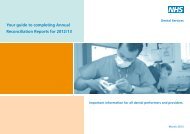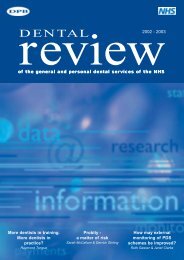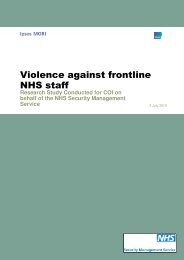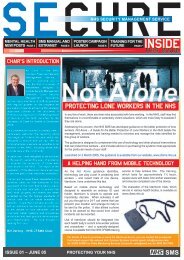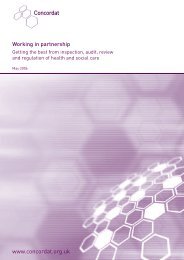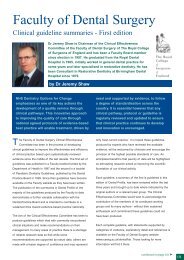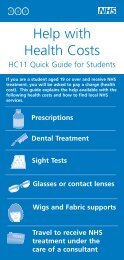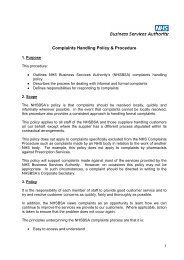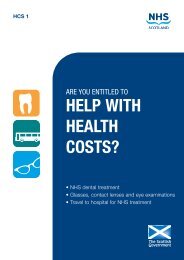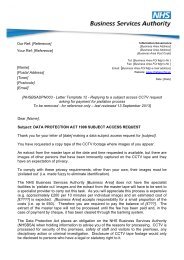Improving security for lone workers Improving security for lone workers
Improving security for lone workers Improving security for lone workers
Improving security for lone workers Improving security for lone workers
- No tags were found...
You also want an ePaper? Increase the reach of your titles
YUMPU automatically turns print PDFs into web optimized ePapers that Google loves.
Insight FAM special– Summer 2009Protecting your NHSnSecurity Management ServiceSecureSAM Edition 2009www.nhsbsa.nhs.uk/<strong>security</strong><strong>Improving</strong> <strong>security</strong><strong>for</strong> <strong>lone</strong> <strong>workers</strong>All NHS organisations are obliged to protect their employees, and this meansmaking different provisions <strong>for</strong> different types of staff. Lone <strong>workers</strong> needadditional organisational support, management and training to deal with thespecific risks they face. They must also be empowered to take a greater degree ofresponsibility <strong>for</strong> their own safety and <strong>security</strong>.Lone working may be defined as any situation or location in which someone works without a colleaguenearby or out of sight or earshot of another colleague. This could be outside health body premises, orinternally, where staff care <strong>for</strong> patients or service users on their own.Following a commitment to <strong>lone</strong> worker safety made by the Health Secretary, the Department of Healthannounced in May 2009 that 30,000 NHS <strong>lone</strong> <strong>workers</strong> would receive personal <strong>security</strong> devices. As wellas discreetly raising an alert if they feel their safety is threatened, staff can use the device to registertheir whereabouts and any perceived risks be<strong>for</strong>e they enter the <strong>lone</strong> working situation, and to monitorand record any incidents that occur.The Department of Health commissioned the NHS Business Services Authority to procure a frameworkagreement <strong>for</strong> the provision of <strong>lone</strong> worker services and the NHS Security Management Service hasprovided guidance <strong>for</strong> NHS bodies that wish to procure services through it.Sue Frith, Deputy Head of the NHS Security Management Service, explains, “The new system helpsprotect NHS staff from violence or abuse and allows action to be taken against those who havecommitted assaults. This helps deliver healthy and safe working conditions and an environmentfree from harassment, bullying or violence, in line with the new NHS Constitution.”The NHS Security Management Service has overseen the training of the first users, who haveSecure – Spring 2009
from frontpagewelcomed the new system. The trainingexplains how the device should be used aspart of preparations <strong>for</strong> <strong>lone</strong> working as wellas <strong>for</strong> dealing with any issues that arise. Byrecording an ‘amber alert’ – a short messageabout their location and how long they expectto be there – a <strong>lone</strong> worker can maximisethe efficiency of an emergency responseshould one be needed. Their message will beretained by the alarm receiving centre (ARC)and listened to if they subsequently raise a redalert because they feel at risk.A red alert creates an open voice call to anexperienced operator at the ARC, who willmonitor the audio from the device, assess thesituation and notify the relevant NHS body’sescalation points and/or emergency services asrequired.The introduction of these devices rein<strong>for</strong>cesmuch good practice already evidentthroughout the NHS to protect <strong>lone</strong><strong>workers</strong>. This includes work by Local SecurityManagement Specialists to ensure therelevant policies and procedures are in place,commitment from <strong>lone</strong> <strong>workers</strong> themselves toconducting risk assessments, and appropriateuse of violent patient schemes, buddy systemsand conflict resolution training. Crucially,the <strong>lone</strong> worker devices also generate audiorecordings that can be used in criminal andcivil proceedings and to take local sanctionsagainst offenders.Supporting guidanceThe NHS Security Management Service hascreated a <strong>lone</strong> worker section on its websitewhere all guidance and other documentsrelating to <strong>lone</strong> working are easily accessible.As well as the framework agreement, termsand conditions and order <strong>for</strong>ms <strong>for</strong> thenew <strong>lone</strong> worker service, the page containsguidance and a template policy that LocalSecurity Management Specialists can use todevelop an individualised <strong>lone</strong> working policy<strong>for</strong> their trust.The template policy guidance should beread in conjunction with the new Not a<strong>lone</strong>guidance <strong>for</strong> <strong>lone</strong> <strong>workers</strong>, which the NHSSecurity Management Service has updatedin line with contributions from a range ofstakeholders – in particular, the Health andSafety Executive and the NHS LitigationAuthority. The annexes include a shortchecklist, summarising the key points <strong>for</strong> linemanagers and their <strong>lone</strong> <strong>workers</strong> and a flowchart of what to do in the event of an incidentof violence or abuse.Tackling nuisance behaviouron NHS premises in England:legislation to be commencedA series of roadshows during Septemberand October took the NHS SecurityManagement Service (NHS SMS) to all 10special health authority areas to explainhow the Criminal Justice and ImmigrationAct 2008 (CJIA) affects the NHS.The focus was on sections 119–120, designedto tackle low-level antisocial behaviour such ascreating excessive noise in waiting areas or wards,using foul language and verbally abusing NHSstaff. Expected to commence in November 2009,the legislation aims to prevent such behaviourfrom escalating to more serious offences such asassault.The CJIA creates a criminal offence of causing anuisance or disturbance on NHS hospital premisesand refusing to leave. It also gives authorised NHSstaff the power to remove a person suspected ofcommitting this offence. The offence and power ofremoval pertain to NHS hospital premises only andwill not apply to patients or those seeking medicaladvice, treatment or care.In line with its commitment to protecting NHSstaff from violence and abuse, the Departmentof Health has charged the NHS SMS withcommunicating, implementing and training NHSstaff in the new powers. The roadshows were halfdayevents, with key speakers from the NHS SMS’sPolicy, Communications and Training teams. Theygave in<strong>for</strong>mation on a range of associated issues,from publicising the changes to learning how toimplement them in practice.The NHS SMS will deliver the appropriate trainingcourses <strong>for</strong> both those NHS staff intending toapply the powers as authorised officers and thosemembers of <strong>security</strong> staff who would subsequentlybe instructed to remove nuisance individuals (socalled‘NHS appropriate staff’).The ‘authorised officer’ is a three-day course andthe ‘NHS appropriate staff’ is a two-and-a-halfdaycourse. An additional one-day mental healthawareness module will be delivered by mentalhealth specialists.The training will be delivered completely freeof charge and will be available from when thepowers commence. Ivana Bartoletti is the CJIAtraining delivery manager and can be contacted atcjia@cfsms.gsi.gov.uk or 020 7895 4534.
Theft of NHS property and assets –a new area <strong>for</strong> risk measurementThe NHS Security Management Service’s Risk Measurement Unit is working closely withthe operations team and Local Security Management Specialists to analyse incidents oftheft in the NHS. As no national data collection has been undertaken in this area, thisexercise will be the first of its kind.The exercise is being piloted in the second half of 2009 with the aim of launching the main exercise inApril 2010, <strong>for</strong> the 2010–2011 financial year. We will be working closely with NHS <strong>security</strong> managementspecialists to target specific groups of NHS assets and identify the nature and scale of losses resulting fromtheft.In the main, the assets focused on will include medical and surgical equipment, IT equipment and staffpersonal issue items, such as uni<strong>for</strong>ms, stab vests and mobile phones. The exercise will also gather datarelating to lead and other metals, drugs, and losses associated with the theft of prescription <strong>for</strong>ms.Input from Local Security Management Specialists will help us to undertake a detailed analysis of theftincidents from a number of health bodies in various regions. We are looking to gather in<strong>for</strong>mation on allof the following:• reported thefts (incidents that have been reported to the police, Local Security ManagementSpecialist, NHS Litigation Authority and any relevant local reporting systems)• discovered but not-reported thefts (incidents that have been reported internally but not to the police,Local Security Management Specialist, etc)• undiscovered and unreported thefts (incidents that have been discovered through investigative work/audit).To support this work, we will be collating feedback from NHS stakeholders including the Audit Commissionand NHS Litigation Authority. The latter records claims from NHS trusts <strong>for</strong> theft incidents of £20,000 andabove and has already received data <strong>for</strong> 1999–2009. In addition, we hope NHS Security Awareness Monthwill raise the profile of theft reporting amongst health body staff at all levels. It is also anticipated that thiswill provide a useful channel <strong>for</strong> obtaining qualitative data relating to unrecorded asset theft.Quality assurance in <strong>security</strong> managementThe NHS Counter Fraud and Security Management Service’s Quality Assurance Unit has added a <strong>security</strong>management quality assurance process to its existing remit. The aim of this will be to agree keyper<strong>for</strong>mance indicators which will <strong>for</strong>m the basis of the <strong>security</strong> management quality assurance process.Taking <strong>for</strong>ward this area of work is John Rodriguez, <strong>for</strong>merly an Area Security Management Specialist inthe NHS Security Management Service. John was appointed to the position of Quality Manager in July2009 and will be visiting the regional quarterly meetings and other specific <strong>for</strong>ums ahead of launchingthe process.
Combating crimethrough designThere are few things that have a greaterimpact on our quality of life than crime andthe fear of crime, and this is particularlytrue of the healthcare sector, according toMike Hodge, Head of Design <strong>for</strong> Security atGreater Manchester Police.Controlling the use and abuse of buildings andtheir occupants through design, construction andsubliminal messages has a dramatic effect on crimeand the fear of crime. Each police <strong>for</strong>ce in thecountry has a dedicated architectural liaison officer(ALO) – a specialist crime prevention officer whodeals with crime risk and designing out crime advice<strong>for</strong> the built environment. In addition to physical<strong>security</strong> measures, they will consider defensiblespace, access, crime and movement generators – allof which can contribute to a reduction in crime anddisorder.The Association of Chief Police Officers (ACPO)introduced the Secured By Design award schemeto promote the principles of Crime PreventionThrough Environmental Design (CPTED) – a crimereduction strategy that acknowledges that layoutand design of the built environment can create orreduce opportunities <strong>for</strong> criminal behaviour anddisorder. The award is made to projects, includinghospitals and other health service facilities, thatcomply with Secured by Design guidelines.Formerly the Greater Manchester PoliceArchitectural Liaison Unit, Design <strong>for</strong> Securityis a specialist unit within Greater ManchesterPolice that works with local authorities, housingassociations, architects, planning consultants anddevelopers to promote designs that address crimeand <strong>security</strong> issues and minimise opportunities <strong>for</strong>offenders. It comprises civilian staff recruited fromthe development professions. They give <strong>security</strong>advice that is both site- and project-specific. Whatis appropriate <strong>for</strong> one development may notnecessarily work <strong>for</strong> a similar development in adifferent location or environment. The degree andtype of <strong>security</strong> deemed necessary and realistic <strong>for</strong>each project is based upon a detailed analysis ofcrime trends in the area and an assessment of thelikely impact of the particular development.
Some of the CPTED principles addressedinclude boundaries, pedestrian andvehicular circulation, surveillance,lighting, and spacial relationshipsbetween buildings. Some examples ofgood practice applicable to health servicepremises are given below:• Offenders prefer targets that offer manyand varied escape routes. For this reason, thenumber and position of access points shouldbe carefully considered.• Public access to private areas should berestricted by the use of appropriate barriers toensure as far as possible that accidental accesscannot be claimed. Psychological as well asphysical barriers may be employed – such assignage and changes in surface colours andtextures.• The layout of a facility is extremely importantin protecting the buildings, their contentsand staff. Sensitive, vulnerable buildingsor equipment should not be positioned inremote or peripheral areas of the facilitybut within locations that are accessibleonly to those who use them and which areoverlooked.• Remote car parks with inadequate boundaryprotection, little or no natural surveillance orpoor lighting soon become crime hot spotsthat are intimidating to both staff and visitors.• Reception desks should be located so as toensure that staff have a clear view of thearea. Access to other areas should requirethat visitors always have to pass the receptioncounter. In the main reception and A&E, alldesk staff should have access to a panic alarmand a readily accessible safe room.• Arson damage can also be a problem <strong>for</strong>health service premises. Refuse storage shouldbe secured and inaccessible – arsonists seldomcarry inflammable material with them, but usewhat they can find on site.
Security incidentreporting systemMeasuring the scale of the problem has always been central to the NHS SecurityManagement Service’s strategy <strong>for</strong> tackling violence against staff. Funding from theDepartment of Health <strong>for</strong> the development of a <strong>security</strong> incident reporting system(SIRS) during 2009–10 means this approach can now also be applied to two other mainareas of the organisation’s work: non-physical abuse and asset protection. By collatingdata, including root cause analysis, from trusts, SIRS will enable local findings to in<strong>for</strong>mnational prevention and deterrence work on a standardised and regular basis – <strong>for</strong> thefirst time ever.“..SIRS will enable local findings to in<strong>for</strong>m nationalprevention and deterrence work...”Data from the system will supplement the range of methods already used by the NHS Security ManagementService – such as risk measurement exercises and research projects – to identify trends and patterns to driveproactive work.Liaison with the range of companies that provide risk management software to NHS bodies is an importantpart of the project. Karen Bonham, who is managing the programme from a user requirements perspective,said, “We identified at an early stage that the ability to receive data securely and with minimal additionalef<strong>for</strong>t on the part of NHS bodies from their risk management systems would be a critical factor in ensuringthe successful achievement of the project’s aims. The workshop we held in Coventry on 3 July confirmedthis <strong>for</strong> us, and we are grateful to the trusts that contributed to the event and have indicated theirwillingness to support the subsequent testing and piloting stages. But we will also need the support of thesmaller proportion of trusts not using commercial software packages and will be contacting them duringthe project to see how we can best work with them to obtain the full picture from across England.”Tony Church, head of the NHS Security Management Service’s In<strong>for</strong>mation Systems Directorate, said, “Witha very challenging deadline to develop an operational system by 31 March 2010, we have appointed aproject manager <strong>for</strong> technical development and to liaise with the risk management companies about theirrequirements. Having previously contributed to the National Patient Safety Agency’s National Reportingand Learning System, she has valuable experience in system development in the NHS arena.”



